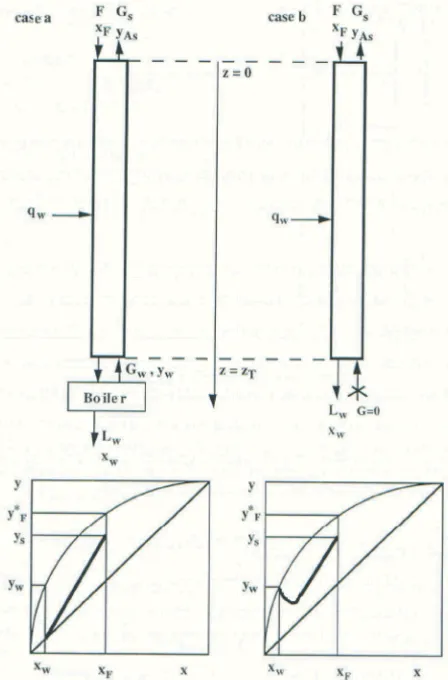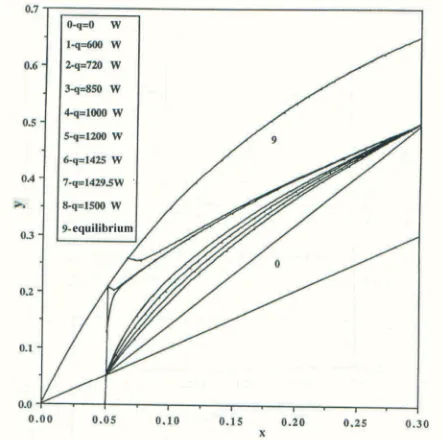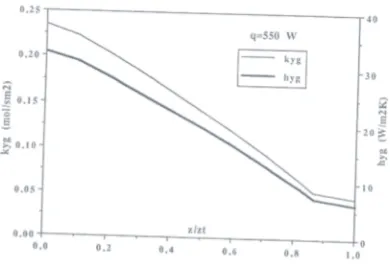ISSN 1818-4952
© IDOSI Publications, 2013
DOI: 10.5829/idosi.wasj.2013.21.1006
Corresponding Author: Khalil Al-Yakoob, Department of Mechanical Engineering, Faculty of Engineering Technology, Universiti Teknikal Malaysia Melaka (UTeM), Hang Tuah Jaya, 76100 Durian Tunggal,
Modelling of Heat and Mass Transfer in the Evaporation of
a Binary Mixture in a Falling Film Apparatus
Khalil Al-Yakoob, Kamaruzaman Jusoff and Linda Khoo Mei Sui
1 2 3
Department of Mechanical Engineering, Faculty of Engineering Technology, Universiti Teknikal
1
Malaysia Melaka (UTeM), Hang Tuah Jaya, 76100 Durian Tunggal, Melaka, Malaysia Department of Forest Production, Faculty of Forestry,
2
Universiti Putra Malaysia, 43400 UPM Serdang, Selangor, Malaysia
Centre for Languages and Human Development, Universiti Teknikal Malaysia Melaka (UTeM),
3
Hang Tuah Jaya, 76100 Durian Tunggal, Melaka, Malaysia
Abstract: A research on a mathematical modeling of simultaneous heat and mass transfer during the process of the evaporation of a saturated binary mixture of n Hexane-Toluene flowing down a tube has been carried out. The flow is characterized by a falling liquid film and the film theory model is used. The geometry retained is a cylindrical column with a smooth uniform heat flux. The objective of the study is to investigate the sensitivity of flow, heat and mass transfer parameters. Functioning and designing of this process on constant transfer parameters will be discussed. The findings show that a higher dependency on the liquid phase parameters along the column height, phase compositions and flux density are found. A further study of the variation of the transfer parameters as a function of the internal flow, composition and chemical properties could be introduced to the given model to establish a model behavior.
Key words: Falling vertical liquid film % Evaporation % Heat and mass transfer % Binary mixture
INTRODUCTION be designed for a low temperature difference where the Falling film evaporator’s concentrators are one of pressure drop caused a low temperature difference and the technological methods which have been extensively a short contact time between the heating surface and used in the chemical process and other industries. the liquid to be evaporated. This is very useful for These evaporators are used for heat and mass transfer working with the heat sensitive materials. The efficient purposes like pharmaceutical applications; food utilization of a heat transfer medium is very important concentration (sugar and syrups, fruit juices and for designing heat and mass purpose as well as for the others), ammonium nitrates, wetted wall for rectification economical purpose.
Fig. 1: Comparison between the conventional process based on the basis of the exchange of mass and energy (case a-with boiler and rectification) and the study between the liquid film and the wall (uniform energy flux case (case b-no vapor flow at the bottom and applied, q , in watt per meter of height) for a differential
evaporation) element height dz as in Figure 2.
the system overall efficiency. This is also due to the fact that the imposed power flux is supplied directly on the falling liquid film by the electromagnetic induction that reduced the conduction losses in the conventional energy transfer. The objective of this study is to investigate the influence of the imposed power on the heat and mass transfer parameters.
MATERIALS AND METHODS
In this study, some major specifications for this type of evaporation process are in a steadily state flow of condition. All of the energy is considered to be transmitted to the liquid film in order to achieve the evaporation process at the gas liquid interface by surface evaporation. The gas flows at the bottom of apparatus should be considered null. The surface area for the heat and mass transfer between phases should be equaled. The last differential element of the height of column provides the equilibrium state between the vapor generated in this element and the liquid film leaving the bottom of the apparatus. The flow is in the same direction in within phases with negligible conduction between the two phases and the contribution of conduction and convection components in the mass and heat transfer are retained.
The mathematical model has been established
w
The exchange between the phases is been corrected for a finite quantity of flux as given by the accomplished through the gas liquid interface double film theory. For a given single phase, the heat which is proposed without having accumulation of and mass transfer coefficients were combined with the mass and in a thermodynamic equilibrium. The Chilton - Colburn analogy. This procedure has been chosen model was established to investigate the conducted in order to reduce the system variable evaporation of several components in the liquid and number.
vapor phase. In this study, there are only two
components present in the given phase, taking into The Resolution Method and the Operating Conditions: account of the counter current circulation of these The system equations may be divided into two components as shown in Figure 2. subgroups [8]. The first group where several nonlinear In order to satisfy the system equations, the algebraic equations are added together with the equations of conservation of mass and energy as well conditions of equilibrium at the interface and the as the boundary conditions and flux of mass have been definitions of mass and energy flux. This sub-system is added. The heat and mass transfer coefficients have solved by the method of Newton-Raphson:
For Liquid phase
Conservation of mass
Conservation of Energy
For Liquid-vapor Interface
Conservation of mass
Conservation of Energy
For the Whole differential Element Conservation of mass
Conservation of Energy
Equilibrium Relation
Summation Relations
Transfer Flux Expression
The second group which contains the differential equations and their resolution provides the gradients for the other end of the element dz. For these equations, a 4 Order Runge-Kutta method has been used, where NC representsth
For these sections, the calculations start from the Residual: L =0.00490(moles/s), x =0.05 in n Hexane, top of the column and work towards the bottom. T = 377.6(K)-Boiling point
This sequence has been chosen because all the Column diameter: 0.058 (m) and zero vapour flow at the conditions needed for starting the program calculations bottom
are known and specified with finite value at the top of the
column. This study has been conducted with the RESULTS AND DISCUSSION assumption of constant values of heat and mass transfer
coefficients from literature geometric shapes. All of Effect of the Incident Energy Q : Figure 3 shows the physical and chemical depend on composition and effect of incident energy q on the axial profiles of
temperature. concentration for the case of constant coefficient of
Data of entry and exit conditions have been taken to heat and mass transfer. These coefficients were fulfill the mass and energy balance around the column calculated by the Chilton - Colburn analogy and are needed to solve the system equations. So the recorded the dew point temperature. Curves numerated conditions and the values at the top of the column from 0 to 9 on the graph where the isobaric are primordial to start the calculations procedure. equilibrium curve between the liquid and vapor are These calculations are developed with the aim of presented as a function of the column height in the obtaining the composition at the bottom of the column rectification mode. In these curves, the composition x and should be verified at the end of calculations. corresponding to the nonzero flow at the bottom of the
For each finite element dz, given the entry data and column were searched.
assumptions for constant heat and mass transfer The imposed power provides the source of heat so coefficients, the method of Newton-Raphson was used that the volatile component n Hexane leaves the liquid to determine the interfacial conditions as well as the flux mixture to the vapor phase. By changing the imposed density across that interface. These results are essential power, the column reacts as a rectification column but the for the method of Runge-Kutta-Merson to give the initial mixture concentration must be changed in order to estimated values at the exit of this finite element dz. satisfy the condition of the absence of gas flow at its Then, the calculation program proceeds to the next finite bottom.
element z+dz and continues to reach the desired Only Curve 6 is obtained for an imposed power
conditions. of 1429 W/m and the output results correspond to
The condtions retained for the mixture n Hexane (A) the desired function of the column. In this case, the and Toulene (B): column is in the evaporation process. It also gives Feed: L =0.0110 (moles/s), x =0.3 in n Hexane,F F almost zero value for the vapor flow. The T = 359.8(K)-Boiling pointF equilibrium composition between vapor and Distillate: G =0.0617(moles/s), y =0.5 in n Hexane,s s liquid phases that fulfill the mass and energy balance T = 366.6(K)-Dew pointgs for the whole column are also shown in Figure 3.
s s
ls
w
w
s
Fig. 3: Variation of the concentration as a function of the imposed power which satisfies the conditions at the bottom of the column with a constant transfer parameters as: k = 1.93 (moles/m s), h = 1300x x
l 2 l
(W/m K) – Chilton - Colburn analogy,2
k =0.2417(moles/m s), h =33.76 (W/m K)y y
g 2 g 2
Chilton - Colburn analogy
Fig. 4: Variation of the vapor composition produced at vapor flow in the bottom of column in function of the the bottom of the column in function of the imposed power can be found. This figure shows high
imposed power sensible variations with respect to the imposed power
Passing this equilibrium point, further heat supply could that the input power is a primordial parameter for this lead the column to an excess of feeding. In this case, the type of apparatus in order to satisfy the thermal and evaporation occurs in a rapid manner and as a result, no hydrodynamic reliable conditions.
equilibrium will be achieved. Incident of liquid and mass transfer coefficients: In Figures 4 and 5 show the evolution of the order to study the effect of the increasing of fluid composition and the flow at the bottom of the column resistance on the liquid heat and mass transfer, (exit) as a function of the imposed power of the same coefficient on the behavior of the model while keeping conditions of heat and mass transfer coefficients. the conditions in the vapor phase are unchanged. Fig. 5: Variation of the vapor flow produced at the bottom
of the column in function of the imposed power
Fig. 6: Variation of the residue flow and composition in function of the imposed power
It could be noticed that the desired composition and vapor flow depends on the applied power as evaporation process on the volatile component from the binary mixture.
Figure 6 shows the non-significant changes in concentration. Non significant effect on the residual flow and column height is shown in Figure 6.
With the same imposed power applied as shown in Figure 3, the composition variations and the desired zero
Fig. 7: Variation of heat and mass transfer coefficient in and also the local internal energy needs. In addition, the liquid phase in function of columns height definition of the applied technique for producing and
Fig. 8: Variation of heat and mass transfer coefficient in 3. Li, W., X. Wu, Z. Luo, S. Yao and J. Xu, 2011. vapor phase in function of columns height Heat transfer characteristics of falling film By changing the value of the imposed power, it is noted Mass Transfer, 54(9-10): 1986-1993.
that the same variation as before but this effect was 4. Park, I.S, 2010. Numerical analysis for flow, heat and clearly noticed with respect to Y and G at the bottom ofw w mass transfer in film flow along a vertical fluted
the column. tube, Int. J. Heat Mass Transfer, 53(1-3): 309-319.
Figure 7 and 8 which have been established for a 5. Engineering Data Book II, 2009. Falling film specified power of 550 W/m as a function of the non- apparatus. Wolverine tube Inc. Retrieved 2009, from: dimensional axe Z/Z . Regarding these variations, anT www.thermalfluidscentral.org/e-resources/
important modification in physical and chemical 6. Prost, J.S., M.T. González and M.J. Urbicain, 2006. properties and flow conditions should be considered. Determination and correlation of heat transfer The effects of these conditions as a function of the coefficients in a falling film evaporator, J. Food Eng., imposed power that fulfill the same bottom column 73(4): 320-326.
conditions. 7. Ribatski, G.J., 2005. Falling-film evaporation on
CONCLUSION 28(5): 635-653.
By modeling the falling film evaporation with the mixture flowing down as a film on a tubular wall specific case, the vapor flow at the column bottom is null. heated by the radial energy provided by induction: The most important parameter noticed is the modeling of the simultaneous heat and mass contribution of the global resistance to transfer. transfer, Ph.D. Thesis, INPT-ENSIGC (ENSACET), It could be noted that higher dependency on the liquid Toulouse, France (in French).
phase parameters on the column height, the phases compositions and the flux density. This model provides the ability to change the operating mode from rectification mode to evaporation mode. The imposed power transmitted through the wall, then transferred by the liquid film to the interface is the principal factor for the exchange between phases. Although this study has been conducted with a constant energetic flux per unit height, it permits to obtain the optimum energy as a function under consideration (composition and/or flow at the bottom of the column)
adopting energy are necessary to achieve the optimal performance.
REFERENCES
1. Pehlivan, H. and M. Özdemir, 2012. Experimental and theoretical investigations of falling film evaporation, Heat Mass Transfer, 48(6): 1071-1079. 2. Chao, Luo, M. Weibin and G. Yulie, 2011. Design of
single vertical tube falling-film evaporation basing on experiment, Journal of Loss Prevention in the Process Industries, 24(5): 695-698.
evaporation on horizontal tube arrays, Int. J. Heat


